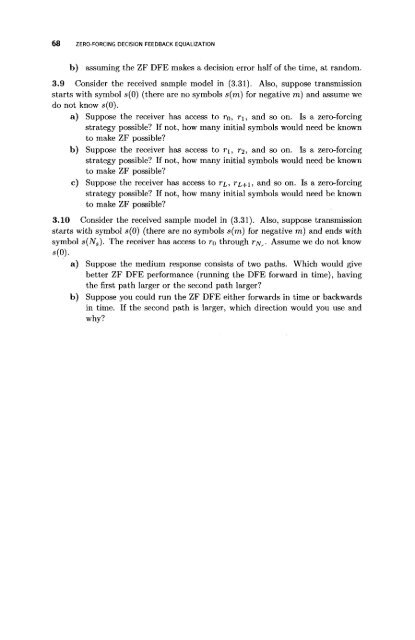mohatta2015.pdf
signal processing from power amplifier operation control point of view
signal processing from power amplifier operation control point of view
You also want an ePaper? Increase the reach of your titles
YUMPU automatically turns print PDFs into web optimized ePapers that Google loves.
68 ZERO-FORCING DECISION FEEDBACK EQUALIZATION<br />
b) assuming the ZF DFE makes a decision error half of the time, at random.<br />
3.9 Consider the received sample model in (3.31). Also, suppose transmission<br />
starts with symbol s(0) (there are no symbols s(m) for negative m) and assume we<br />
do not know s(0).<br />
a) Suppose the receiver has access to r 0 , rj, and so on. Is a zero-forcing<br />
strategy possible? If not, how many initial symbols would need be known<br />
to make ZF possible?<br />
b) Suppose the receiver has access to r\, Γ2, and so on. Is a zero-forcing<br />
strategy possible? If not, how many initial symbols would need be known<br />
to make ZF possible?<br />
c) Suppose the receiver has access to r¿, r^+1 , and so on. Is a zero-forcing<br />
strategy possible? If not, how many initial symbols would need be known<br />
to make ZF possible?<br />
3.10 Consider the received sample model in (3.31). Also, suppose transmission<br />
starts with symbol s(0) (there are no symbols s(m) for negative m) and ends with<br />
symbol s(N s ). The receiver has access to r n through rjv · Assume we do not know<br />
e(0).<br />
a) Suppose the medium response consists of two paths. Which would give<br />
better ZF DFE performance (running the DFE forward in time), having<br />
the first path larger or the second path larger?<br />
b) Suppose you could run the ZF DFE either forwards in time or backwards<br />
in time. If the second path is larger, which direction would you use and<br />
why?



